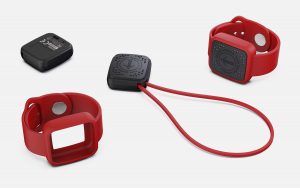Social-Distance–Alert Devices Help Keep Broadcast Environments Safe
Manufacturers are developing and adapting products to meet coronavirus protocols
Story Highlights
Social distancing is necessary for keeping the COVID-19 at bay. However, it’s not easy to achieve when broadcast professionals have to work together, sometimes in closer quarters than might be prudent.
That distancing need, though, is sparking its own category of technology products. Social Distancer Technologies, a joint venture of Canadian technology companies Promark Electronics and CMP Advanced Mechanical Solutions, is marketing just such a solution. The Social Distancer is a credit-card size, 1-in.-thick patent-pending device that calculates the distance between people. It has three methods of alert — visual, vibration, and tone — for instant notification. If crew members are within 8 ft. of one another, the device will flash red, vibrate, and audibly alert them to move farther apart.

Riedel Communications’ DisTag monitoring device alerts its wearer when the mandatory minimum distance from other people is about to be breached.
More specific to the broadcast industry, intercom manufacturer Riedel Communications on June 23 introduced DisTag, a distance-monitoring device worn around the neck or carried in a pocket. The small (approximately 3½- x 1½-in.) and light (2-oz.) unit immediately alerts its wearer via two-stage vibration alarm (haptic), a two-stage LED signal (visual), and a two-stage sound signal (audible) whenever the mandatory minimum distance from other people is about to be breached. Proximity limits of the warning signals can be individually defined and adjusted in accordance with local regulations for social distance.
“After weeks of quarantines and other limitations due to the coronavirus pandemic, our society is gradually returning to normal, but it’s a new type of normal,” says Thomas Riedel, CEO, Riedel Communications. “Slowing the spread of the virus is still a number-one priority as key industries, organizations, and institutions start to reopen and people begin returning to work. In recent months, we’ve learned as a community to adapt to new behavior patterns and situations, and a fundamental aspect is for employees, visitors, and customers to maintain a safe distance from each other. That’s where the new DisTag device comes into play.”
A similar approach is taken by wireless-systems manufacturer IK Multimedia. The Italian company’s new Safe Spacer is a patent-pending wearable that helps wearers maintain safe social distance, alerting them via light, vibration, and sound when units come within 6 ft. of each other. Its ultra-wideband technology uses Bluetooth and can be worn on a wristband, lanyard, or keychain. The device also features a unique ID tag and built-in memory that allows contact tracing in the event of coronavirus exposure, helping keep organizations secure.
Mechanical Approach
Other manufacturers are developing variations on existing products to help establish social distancing during broadcast work. DPA Microphones introduced the 4097 CORE micro shotgun microphone based on the brand’s supercardioid Choir microphone and optimized to pick up speech from a distance. As part of the company’s new 4097 CORE interview kit, the 12-oz. mic and its lightweight boom allow users to conduct interviews from up to 6½ ft. away. The kit features one each of DPA’s new 4099 cold-shoe mount, which incorporates a quarter-inch thread; DPA MicroDot cable; transmitter plate; and lightweight telescopic boom pole to further ensure that social-distance protocols are met. Terminating in a MicroDot connection, the 4097 CORE Micro shotgun can attach directly to a transmitter or be used with the company’s 4099 series mounts, clamps, and clips for easy mounting on any surface. The mic can also be used as a plant-mic solution for film- and TV-production environments.
“Prior to social-distancing protocols, a typical interview incorporated standard handheld or lavalier mics,” says René Mørch, product manager, DPA Microphones. “The 4097 CORE Micro shotgun provides professional sound in a lightweight package, which is perfect for current production needs.”
In addition, some pro-audio manufacturers have shifted to making protective gear and sanitizer products. Audio-systems manufacturer Atlas IED, for example, adapted its manufacturing infrastructure to making face shields, which people can apply for on the company’s website. (These are currently backordered, but the website is taking wait-list requests.)
According to Joel Guilbert, technology development manager, Dale Pro Audio, product development around this is beginning to accelerate after a slow start.
“We’ve actually had the most definitive discussions with some educational facilities as they have a ‘hard start’ for the planned fall semester,” he says, regarding the looming collegiate-sports season. “Lots of Plexiglas and window-style intercoms are coming up. Also, we’ve been seeing a lot of microphone and headset covers arriving. And a number of rep companies we deal with are [promoting] doorway entry temperature-testing systems.”
For pro audio, Guilbert says, the impact of COVID-19 reaches beyond social distancing. Aside from the intelligibility problems caused by masks, the way sports productions accommodate spectators will also impact the venue sound.
“We are looking at the need for better sound distribution for larger spaces: a 500-seat venue will not have 60 people huddled in the first third of the space but [rather] distributed throughout the space,” he explains. “Where people made concessions with the rear one-third coverage of the facility not being optimal because it wasn’t important, they won’t have this option any longer if they want to fully utilize [and monetize] their space.”
Although dedicated devices and adaptations to existing kit will help stem transmission of the virus to some extent, the best solutions have thus far been to keep A1s and others literally at home. That was the case for the recent Belmont Stakes race in Elmont, NY. There, NBC Sports limited its onsite presence to a just a small crew and its proprietary NEWBERT remote flypack. The rest of the production team worked from a control room at NBC Sports Group’s International Broadcast Center in Stamford, CT.

